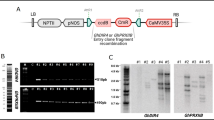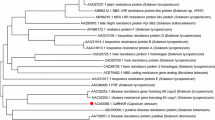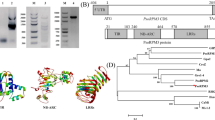Abstract
Root-knot nematodes are obligate parasites that invade the roots of agricultural plants and induce the formation of specialized feeding structures, especially races 3 and 4 of the southern root-knot nematode. However, not much is known about the defense mechanisms of plants against the invasion of M. incognita race 1. In this study, we characterized and performed functional analysis of the CC-NBS-LRR domain gene, GHNTR1. Using the GHNTR1 promoter to drive the GUS marker gene, we found that GUS expression was high in the roots and shoots of seedlings, four leaves stages, and mature stages. When GHNTR1 was transiently expressed in Nicotiana. benthamiana and Nicotiana. tabacum, necrosis was observed in the leaves and detectable amounts of H2O2 had accumulated when compared to the control plants. Stable transformation of N. benthamiana with the GHNTR1 gene using Agrobacterium induced the expression of defense marker genes PR1, PR2, LOX, and ERF1. In addition, the transgenic N. benthamiana and N. tabacum plants exhibited higher resistance to M. incognita infection. When transgenic N. tabacum were challenged with M. incognita, callose deposition and peroxide accumulation were observed in the roots by aniline-blue and DAB staining, respectively. Sequencing and bioinformatic analysis of small RNA revealed 48 miRNAs were up-regulated and 32 miRNAs were down-regulated. Further, 345 genes were predicted as targets of miRNAs and these included genes that are involved in cell death, death, and stress response. Thus, GHNTR1 is the first gene isolated from cotton that confers resistance against M. incognita and it induced a series of hypersensitive responses in transgenic tobacco. These findings improve our understanding of the molecular mechanisms of the response of upland cotton to M. incognita infection.





Similar content being viewed by others
References
Alexa, A., Rahnenführer, J., & Lengauer, T. (2006). Improved scoring of functional groups from gene expression data by decorrelating GO graph structure. Bioinformatics, 22, 1600–1607.
Ali, M. A., Abbas, A., Kreil, D., & Bohlmann, H. (2013). Overexpression of the transcription factor RAP2.6 leads to enhanced callose deposition in syncytia and enhanced resistance against the beet cyst nematode Heterodera schachtii in Arabidopsis roots. BMC Plant Biology, 13, 47.
Almagro, L., Gómez Ros, L. V., Belchi-Navarro, S., Bru, R., Ros Barceló, A., & Pedreño, M. A. (2009). Class III peroxidases in plant defence reactions. Journal of Experimental Botany, 60, 377–390.
Ambros, V., Bartel, B., Bartel, D. P., Burge, C. B., Carrington, J. C., Chen, X., Dreyfuss, G., Eddy, S. R., Griffiths-Jones, S., Marshall, M., Matzke, M., Ruvkun, G., & Tuschl, T. (2003). A uniform system for microRNA annotation. RNA, 9, 277–279.
Artico, S., Nardeli, S., Brilhante, O., Grossi-de-Sa, M., & Alves-Ferreira, M. (2010). Identification and evaluation of new reference genes in Gossypium hirsutum for accurate normalization of real-time quantitative RT-PCR data. BMC Plant Biology, 10, 49.
Aryal, S. K., Davis, R., Stevenson, K. L., Timper, P., & Ji, P. (2011). Influence of infection of cotton by rotylenchulus reniformis and Meloidogyne incognita on the production of enzymes involved in systemic acquired resistance. Journal of Nematology, 43, 152–159.
Blok, V. C., Jones, J. T., Phillips, M. S., & Trudgill, D. L. (2008). Parasitism genes and host range disparities in biotrophic nematodes: the conundrum of polyphagy versus specialisation. BioEssays, 30, 249–259.
Branch, C., Hwang, C.-F., Navarre, D. A., & Williamson, V. M. (2004). Salicylic acid is part of the Mi-1-mediated defense response to root-knot nematode in tomato. Molecular Plant-Microbe Interactions, 17, 351–356.
Burge, C., & Karlin, S. (1997). Prediction of complete gene structures in human genomic DNA. Journal of Molecular Biology, 268, 78–94.
Burge SW, Daub J, Eberhardt R, Tate J, Barquist L, Nawrocki EP, Eddy SR, Gardner PP, Bateman A (2012) Rfam 11.0: 10 years of RNA families. Nucleic acids research, 41, D226–D232.
Callahan, F. E., Jenkins, J. N., Creech, R., & Lawrence, G. (1997). Changes in cotton root proteins correlated with resistance to root knot nematode development. Journal of Cotton Science, 1, 38–47.
Callahan, F. E., Zhang, X.-D., Ma, D.-P., Jenkins, J. N., Hayes, R. W., & Tucker, M. L. (2004). Comparison of MIC-3 protein accumulation in response to root-knot nematode infection in cotton lines displaying a range of resistance levels. Journal of Cotton Science, 8, 186–190.
Cao, H., Bowling, S. A., Gordon, A. S., & Dong, X. (1994). Characterization of an Arabidopsis mutant that is nonresponsive to inducers of systemic acquired resistance. The Plant Cell Online, 6, 1583–1592.
Cheng, X., Jiang, H., Zhao, Y., Qian, Y., Zhu, S., & Cheng, B. (2010). A genomic analysis of disease-resistance genes encoding nucleotide binding sites in Sorghum bicolor. Genetics and Molecular Biology, 33, 292–297.
Claverie, M., Dirlewanger, E., Bosselut, N., Van Ghelder, C., Voisin, R., Kleinhentz, M., Lafargue, B., Abad, P., Rosso, M.-N., Chalhoub, B., & Esmenjaud, D. (2011). The Ma gene for complete-spectrum resistance to Meloidogyne species in Prunus is a TNL with a huge repeated C-terminal post-LRR region. Plant Physiology, 156, 779–792.
Cook, C. G., Robinson, A. F., & Namken, L. N. (1997). Tolerance to Rotylenchulus reniformis and resistance to Meloidogyne incognita race 3 in high-yielding breeding lines of Upland cotton. Journal of Nematology, 29, 322–328.
Das, S., DeMason, D. A., Ehlers, J. D., Close, T. J., & Roberts, P. A. (2008). Histological characterization of root-knot nematode resistance in cowpea and its relation to reactive oxygen species modulation. Journal of Experimental Botany, 59, 1305–1313.
Du, Z., Zhou, X., Ling, Y., Zhang, Z., & Su, Z. (2010). agriGO: a GO analysis toolkit for the agricultural community. Nucleic Acids Research, 38, W64–W70.
Ewing, B., & Green, P. (1998). Base-calling of automated sequencer traces using phred. II. Error probabilities. Genome Research, 8, 186–194.
Ewing, B., Hillier, L., Wendl, M. C., & Green, P. (1998). Base-calling of automated sequencer traces UsingPhred. I. Accuracy assessment. Genome Research, 8, 175–185.
Fudali, S. L., Wang, C., & Williamson, V. M. (2012). Ethylene signaling pathway modulates attractiveness of host roots to the root-knot nematode Meloidogyne hapla. Molecular Plant-Microbe Interactions, 26, 75–86.
Glazebrook, J. (2005). Contrasting mechanisms of defense against biotrophic and necrotrophic pathogens. Annual Review of Phytopathology, 43, 205–227.
Griffiths-Jones, S., Grocock, R. J., van Dongen, S., Bateman, A., & Enright, A. J. (2006). miRBase: microRNA sequences, targets and gene nomenclature. Nucleic Acids Research, 34, D140–D144.
Gutiérrez, O., Jenkins, J., McCarty, J., Wubben, M., Hayes, R., & Callahan, F. (2010). SSR markers closely associated with genes for resistance to root-knot nematode on chromosomes 11 and 14 of Upland cotton. Theoretical and Applied Genetics, 121, 1323–1337.
Hafner, M., Landgraf, P., Ludwig, J., Rice, A., Ojo, T., Lin, C., Holoch, D., Lim, C., & Tuschl, T. (2008). Identification of microRNAs and other small regulatory RNAs using cDNA library sequencing. Methods, 44, 3–12.
He, Y., Kumar, P., Shen, X., Davis, R., Van Becelaere, G., May, O. L., Nichols, R., & Chee, P. (2014). Re-evaluation of the inheritance for root-knot nematode resistance in the Upland cotton germplasm line M-120 RNR revealed two epistatic QTLs conferring resistance. Theoretical and Applied Genetics, 127, 1343–1351.
Higo, K., Ugawa, Y., Iwamoto, M., & Korenaga, T. (1999). Plant cis-acting regulatory DNA elements (PLACE) database: 1999. Nucleic Acids Research, 27, 297–300.
Horsch, R. B., & Klee, H. J. (1986). Rapid assay of foreign gene expression in leaf discs transformed by Agrobacterium tumefaciens: Role of T-DNA borders in the transfer process. Proceedings of the National Academy of Sciences, 83, 4428–4432.
Hulbert, S. H., Webb, C. A., Smith, S. M., & Sun, Q. (2001). RESISTANCE GENE COMPLEXES: evolution and utilization. Annual Review of Phytopathology, 39, 285–312.
Hussey, B., & Barker, K. (1973). Comparison of methods of collecting inocula of Meloidogyne spp. including a new technique. Plant Disease Report, 57, 1025–1028.
Jaouannet, M., Magliano, M., Arguel, M. J., Gourgues, M., Evangelisti, E., Abad, P., & Rosso, M. N. (2012). The root-knot nematode calreticulin Mi-CRT is a Key effector in plant defense suppression. Molecular Plant-Microbe Interactions, 26, 97–105.
Jefferson, R., Kavanagh, T., & Bevan, M. (1987). GUS fusions:B-glucuronidase as a sensitive and versatile gene fusion marker in higher plants. The EMBO Journal, 6, 3901–3907.
Kelley, L. A., & Sternberg, M. J. E. (2009). Protein structure prediction on the Web: a case study using the phyre server. Nature Protocols, 4, 363–371.
Koenning, S. R., Barker, K. R., & Bowman, D. T. (2001). Resistance as a tactic for management of Meloidogyne incognita on cotton in North Carolina. Journal of Nematology, 33, 126–131.
Langmead, B., & Salzberg, S. L. (2012). Fast gapped-read alignment with Bowtie 2. Nature Methods, 9, 357–359.
Lee, Y., Jeon, K., Lee, J. T., Kim, S., & Kim, V. N. (2002). MicroRNA maturation: stepwise processing and subcellular localization. EMBO Journal, 21(17), 4663–4670.
Letunic, I., Doerks, T., & Bork, P. (2012). SMART 7: recent updates to the protein domain annotation resource. Nucleic Acids Research, 40, D302–D305.
Luna, E., Pastor, V., Robert, J., Flors, V., Mauch-Mani, B., & Ton, J. (2010). Callose deposition: a multifaceted plant defense response. Molecular Plant-Microbe Interactions, 24, 183–193.
Meyers, B. C., Kozik, A., Griego, A., Kuang, H., & Michelmore, R. W. (2003). Genome-wide analysis of NBS-LRR–encoding genes in Arabidopsis. The Plant Cell Online, 15, 809–834.
Milligan, S. B., Bodeau, J., Yaghoobi, J., Kaloshian, I., Zabel, P., & Williamson, V. M. (1998). The root knot nematode resistance gene Mi from tomato is a member of the leucine zipper, nucleotide binding, leucine-rich repeat family of plant genes. The Plant Cell Online, 10, 1307–1319.
Molinari, S., Fanelli, E., & Leonetti, P. (2014). Expression of tomato salicylic acid (SA)-responsive pathogenesis-related genes in Mi-1-mediated and SA-induced resistance to root-knot nematodes. Molecular Plant Pathology, 15, 255–264.
Nahar, K., Kyndt, T., De Vleesschauwer, D., Höfte, M., & Gheysen, G. (2011). The jasmonate pathway is a key player in systemically induced defense against root knot nematodes in rice. Plant Physiology, 157, 305–316.
Niu, C., Hinchliffe, D. J., Cantrell, R. G., Wang, C., Roberts, P. A., & Zhang, J. (2007). Identification of molecular markers associated with root-knot nematode resistance in upland cotton all rights reserved. No part of this periodical may be reproduced or transmitted in any form or by any means, electronic or mechanical, including photocopying, recording, or any information storage and retrieval system, without permission in writing from the publisher. Permission for printing and for reprinting the material contained herein has been obtained by the publisher. Crop Science, 47, 951–960.
Nobuta, K., Lu, C., Shrivastava, R., Pillay, M., De Paoli, E., Accerbi, M., Arteaga-Vazquez, M., Sidorenko, L., Jeong, D.-H., Yen, Y., Green, P. J., Chandler, V. L., & Meyers, B. C. (2008). Distinct size distribution of endogenous siRNAs in maize: Evidence from deep sequencing in the mop1-1 mutant. Proceedings of the National Academy of Sciences, 105, 14958–14963.
Parkhi, V., Kumar, V., Campbell, L., Bell, A., Shah, J., & Rathore, K. (2010). Resistance against various fungal pathogens and reniform nematode in transgenic cotton plants expressing Arabidopsis NPR1. Transgenic Research, 19, 959–975.
Perazza, D., Vachon, G., & Herzog, M. (1998). Gibberellins promote trichome formation by Up-RegulatingGLABROUS1 in Arabidopsis. Plant Physiology, 117, 375–383.
Priya, D. B., Somasekhar, N., Prasad, J., & Kirti, P. (2011). Transgenic tobacco plants constitutively expressing Arabidopsis NPR1 show enhanced resistance to root-knot nematode, Meloidogyne incognita. BMC Research Notes, 4, 231.
Robinson, A. F. B. A., & Percival, A. E. (2004). New sources of resistance to the reniform (Rotylenchulus reniformis Linford and Oliveira) and root-knot (Meloidogyne incognita (Kofoid & White) Chitwood) nematode in upland (Gossypium hirsutum L.) and Sea island (G. barbadense L.) cotton. The Journal of Cotton Science, 8, 191–197.
Shen, X., Van Becelaere, G., Kumar, P., Davis, R., May, O. L., & Chee, P. (2006). QTL mapping for resistance to root-knot nematodes in the M-120 RNR Upland cotton line (Gossypium hirsutum L.) of the Auburn 623 RNR source. Theoretical and Applied Genetics, 113, 1539–1549.
Slootweg, E. J., Spiridon, L. N., Roosien, J., Butterbach, P., Pomp, R., Westerhof, L., Wilbers, R., Bakker, E., Bakker, J., Petrescu, A.-J., Smant, G., & Goverse, A. (2013). Structural determinants at the interface of the ARC2 and leucine-rich repeat domains control the activation of the plant immune receptors Rx1 and Gpa2. Plant Physiology, 162, 1510–1528.
Tamura, K., Stecher, G., Peterson, D., Filipski, A., & Kumar, S. (2013). MEGA6: molecular evolutionary genetics analysis version 6.0. Molecular Biology and Evolution, 30, 2725–2729.
Tan, S., & Wu, S. (2012). Genome wide analysis of nucleotide-binding site disease resistance genes in brachypodium distachyon. Comparative and Functional Genomics, 2012, 12.
Teillet, A., Dybal, K., Kerry, B. R., Miller, A. J., Curtis, R. H. C., & Hedden, P. (2013). Transcriptional changes of the root-knot nematode <italic>Meloidogyne incognita</italic> in response to <italic>Arabidopsis thaliana</italic> root signals. PLoS One, 8, e61259.
Thordal-Christensen, H., Zhang, Z., Wei, Y., & Collinge, D. B. (1997). Subcellular localization of H2O2 in plants. H2O2 accumulation in papillae and hypersensitive response during the barley—powdery mildew interaction. The Plant Journal, 11, 1187–1194.
Uehara, T., Sugiyama, S., Matsuura, H., Arie, T., & Masuta, C. (2010). Resistant and susceptible responses in tomato to cyst nematode are differentially regulated by salicylic acid. Plant and Cell Physiology, 51, 1524–1536.
Wang, C., Ulloa, M., & Roberts, P. A. (2006). Identification and mapping of microsatellite markers linked to a root-knot nematode resistance gene (rkn1) in Acala NemX cotton (Gossypium hirsutum L.). Theoretical and Applied Genetics, 112, 770–777.
Wu H-J, Ma Y-K, Chen T, Wang M, Wang X-J (2012) PsRobot: a web-based plant small RNA meta-analysis toolbox. Nucleic acids research, 40, W22–W28.
Yan, N., Gu, L., Kokel, D., Chai, J., Li, W., Han, A., Chen, L., Xue, D., & Shi, Y. (2004). Structural, biochemical, and functional analyses of CED-9 recognition by the proapoptotic proteins EGL-1 and CED-4. Molecular Cell, 15, 999–1006.
Yang, H., Yang, S., Li, Y., & Hua, J. (2007). The Arabidopsis BAP1 and BAP2 genes Are general inhibitors of programmed cell death. Plant Physiology, 145, 135–146.
Ynturi, P., Jenkins, J. N., McCarty, J. C., Gutierrez, O. A., & Saha, S. (2006). Association of root-knot nematode resistance genes with simple sequence repeat markers on Two chromosomes in cotton mention of trade names or commercial products in this manuscript does not imply recommendations or endorsement by the USDA. Joint Contribution of USDA, ARS, and Mississippi State University. Journal paper No.J-10952 of Mississippi Agricultural and Forestry Experiment Station. Crop Science, 46, 2670–2674.
Youssef, R., MacDonald, M., Brewer, E., Bauchan, G., Kim, K.-H., & Matthews, B. (2013). Ectopic expression of AtPAD4 broadens resistance of soybean to soybean cyst and root-knot nematodes. BMC Plant Biology, 13, 67.
Yu, X., Tang, J., Wang, Q., Ye, W., Tao, K., Duan, S., Lu, C., Yang, X., Dong, S., Zheng, X., & Wang, Y. (2012). The RxLR effector Avh241 from Phytophthora sojae requires plasma membrane localization to induce plant cell death. New Phytologist, 196, 247–260.
Zhang, X.-D., Callahan, F. E., Jenkins, J. N., Ma, D.-P., Karaca, M., Saha, S., & Creech, R. G. (2002). A novel root-specific gene, MIC-3, with increased expression in nematode-resistant cotton (Gossypium hirsutum L.) after root-knot nematode infection. Biochimica et Biophysica Acta (BBA) - Gene Structure and Expression, 1576, 214–218.
Zhang, B., Yang, Y., Ni, W., She, J., Shen, X., He, X., Zhang, X., Xu, Y., & Yao, S. (2006). Cloning and characterization of a CC-NBS-LRR gene in upland cotton. Jiangsu Journal of Agricultural Sciences , 22, 351–355.
Zhang, F.-Q., Wang, Y.-S., Lou, Z.-P., & Dong, J.-D. (2007). Effect of heavy metal stress on antioxidative enzymes and lipid peroxidation in leaves and roots of two mangrove plant seedlings (Kandelia candel and Bruguiera gymnorrhiza). Chemosphere, 67, 44–50.
Acknowledgments
This work was supported to B.Z. by grants from the National Natural Science Foundation of China (No. 31371930), National Science and Technology Major Project for Transgenic Breeding (No. 2014ZX0800501B) and the fund for Independent Innovation of Agricultural Sciences in Jiangsu Province (No. cx(13) 2029).
Authors’ contributions
BLZ, YWY, JYW and WHZ performed the data analysis and drafted the manuscript. BLZ, YWY, and JYW participated in the analysis of the data. LXT, ZZH, TLL and TZC performed the experiments. All authors approved the final version of the manuscript.
Competing interests
The authors declare that they have no conflict of interest.
Author information
Authors and Affiliations
Corresponding author
Electronic supplementary material
Below is the link to the electronic supplementary material.
Supplementary table 1
List of primers used in this study. (XLS 26 kb)
Supplementary table 2
Summary of the predicted miRNA in wild-type and transgenic N. benthamiana plants. (XLS 177 kb)
Supplementary table 3
Annotation of differentially expressed miRNA target genes. (XLS 736 kb)
Supplementary table 4
GO enrichment analysis of the target genes. (XLS 32 kb)
Supplementary Figure 1
Relative expression level of GHNTR1 gene in transgenic plants. A. The transgenic N. tabacum plants. B. Transgenic N. benthamiana plants. (JPEG 1136 kb)
Supplementary Figure 2
The phenotype and expression of PR genes in transgenic N. tabacum plants. A. The phenotype of aboveground parts in transgenic N. tabacum plants. B. Expression level of PR genes without M. incognita infection in transgenic N. tabacum plants. (JPEG 4966 kb)
Rights and permissions
About this article
Cite this article
Zhang, B., Yang, Y., Wang, J. et al. A CC-NBS-LRR type gene GHNTR1 confers resistance to southern root-knot nematode in Nicotiana.benthamiana and Nicotiana.tabacum . Eur J Plant Pathol 142, 715–729 (2015). https://doi.org/10.1007/s10658-015-0646-3
Accepted:
Published:
Issue Date:
DOI: https://doi.org/10.1007/s10658-015-0646-3




